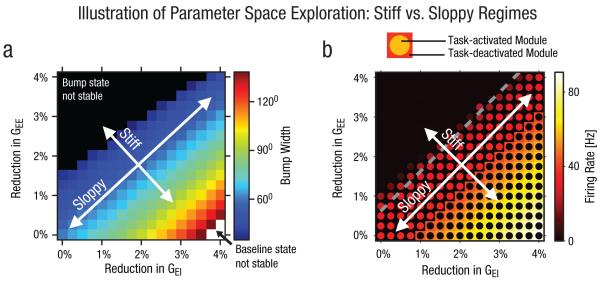Fig. 3.
Schematic of how modeling can serve to characterize synaptic parameter dependence. The graphs illustrate a parameter space of manipulating excitation (E) and inhibition (I) balance within circuit models of working memory (for complete details, see J. D. Murray et al., 2014). The purpose of this analysis was to illustrate how the model depends on level of perturbation of a given parameter. This example analysis illustrates a set of regimes along the diagonal (highlighted by the blue diagonal) where the model behavior was robust to manipulation of both E and I parameters. This parameter space illustrates that the model is robust as long as E/I balance is preserved (“sloppy” axis). In contrast, even subtle alterations in either E or I parameters (upper left and lower right quadrants) highlight that the model is sensitive along these parameters (“stiff” axis). That is, even a subtle alteration along these variables pushes the model out of a robust regime. This effect is captured in the graph in (a), which shows a biophysically based model at the microcircuit level (J. D. Murray et al., 2014), as well as in the graph in (b) when extended to model system-level interactions (Anticevic, Gancsos, et al., 2012; Yang et al., 2014). GEE = recurrent excitation from excitatory (E) onto excitatory (E) cells; GEI = feedback inhibition from excitatory (E) onto inhibitory (I) cells.

